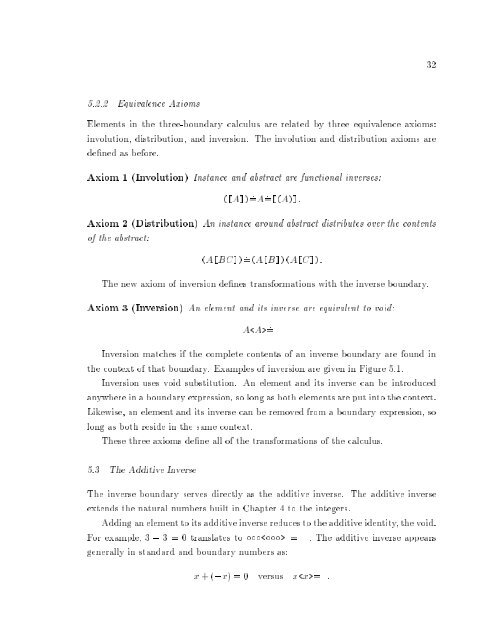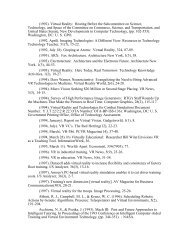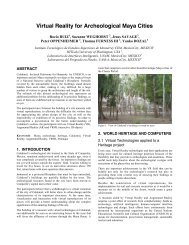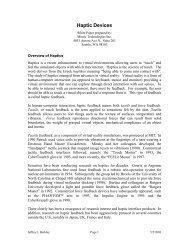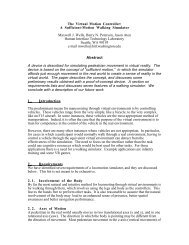A Calculus of Number Based on Spatial Forms - University of ...
A Calculus of Number Based on Spatial Forms - University of ...
A Calculus of Number Based on Spatial Forms - University of ...
You also want an ePaper? Increase the reach of your titles
YUMPU automatically turns print PDFs into web optimized ePapers that Google loves.
32<br />
5.2.2 Equivalence Axioms<br />
Elements in the three-boundary calculus are related by three equivalence axioms:<br />
involuti<strong>on</strong>, distributi<strong>on</strong>, and inversi<strong>on</strong>. The involuti<strong>on</strong> and distributi<strong>on</strong> axioms are<br />
dened as before.<br />
Axiom 1 (Involuti<strong>on</strong>) Instance and abstract are functi<strong>on</strong>al inverses:<br />
([A]) : =A : =[(A)]:<br />
Axiom 2 (Distributi<strong>on</strong>) An instance around abstract distributes over the c<strong>on</strong>tents<br />
<str<strong>on</strong>g>of</str<strong>on</strong>g> the abstract:<br />
(A[BC]) : =(A[B])(A[C]):<br />
The new axiom <str<strong>on</strong>g>of</str<strong>on</strong>g> inversi<strong>on</strong> denes transformati<strong>on</strong>s with the inverse boundary.<br />
Axiom 3 (Inversi<strong>on</strong>) An element and its inverse are equivalent to void:<br />
A : =<br />
Inversi<strong>on</strong> matches if the complete c<strong>on</strong>tents <str<strong>on</strong>g>of</str<strong>on</strong>g> an inverse boundary are found in<br />
the c<strong>on</strong>text <str<strong>on</strong>g>of</str<strong>on</strong>g> that boundary. Examples <str<strong>on</strong>g>of</str<strong>on</strong>g> inversi<strong>on</strong> are given in Figure 5.1.<br />
Inversi<strong>on</strong> uses void substituti<strong>on</strong>. An element and its inverse can be introduced<br />
anywhere in a boundary expressi<strong>on</strong>, so l<strong>on</strong>g as both elements are put into the c<strong>on</strong>text.<br />
Likewise, an element and its inverse can be removed from a boundary expressi<strong>on</strong>, so<br />
l<strong>on</strong>g as both reside in the same c<strong>on</strong>text.<br />
These three axioms dene all <str<strong>on</strong>g>of</str<strong>on</strong>g> the transformati<strong>on</strong>s <str<strong>on</strong>g>of</str<strong>on</strong>g> the calculus.<br />
5.3 The Additive Inverse<br />
The inverse boundary serves directly as the additive inverse. The additive inverse<br />
extends the natural numbers built in Chapter 4 to the integers.<br />
Adding an element to its additiveinverse reduces to the additive identity, the void.<br />
For example, 3 , 3 = 0 translates to = : The additive inverse appears<br />
generally in standard and boundary numbers as:<br />
x +(,x)=0 versus x= :


